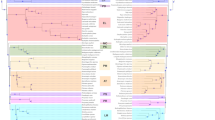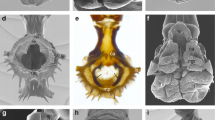Abstract
Anastrepha fraterculus is an important pest of commercial fruits in South America. The variability observed for morphological and behavioural traits as well as genetic markers suggests that A. fraterculus represents a complex of synmorphic species rather than a single biological species. We studied the correlation between geographical distribution and genetic variation in natural populations from Argentina and south Brazil. Fragments of the mitochondrial gene COII were sequenced in 28 individuals. The matrix of aligned sequences was phylogenetically analysed by parsimony, yielding a cladogram of haplotypes. Based on Templeton’s nested method, no clade showed any geographic pattern for the gene COII, indicating lack of significant association between haplotypic variability and geographic distribution. The analysis of nucleotide substitution distances by Neighbour-Joining algorithm showed that geographically distant populations exhibit low genetic distances. The corresponding trees clustered the populations without showing any geographic pattern. This result suggests that the populations studied are not reproductively isolated.




Similar content being viewed by others
References
Alberti AC, Calcagno G, Saidman BO, Vilardi JC (1999) Analysis of the genetic structure of a natural population of Anastrepha fraterculus (Diptera: Tephritidae). Ann Entomol Soc Am 92(5):731–736
Alberti AC, Rodriguero MS, Gomez Cendra P, Saidman BO, Vilardi JC (2002) Evidence indicating that a Argentine populations of Anastrepha fraterculus (Diptera: Tephritidae) belong to a single biological species. Ann Entomol Soc Am 95(4):505–512
Aluja M (1994) Biomomics and management of Anastrepha. Annu Rev Entomol 39:155–178
Baker AC, Stone WE, Plummer CC, McPhail H (1944) A review of studies on the Mexican fruit fly and related Mexican species. United States Dept Agric Miscellaneous Publication V 531:1–155
Baruffi L, Damiani G, Guglielmino CR, Bandis C, Malacrida AR, Gasperi G (1995) Polymorphism within and between populations of Ceratitis capitata: comparison between RAPD and multilocus enzyme electrophoresis data. Heredity 74:425–437
BioEdit sequence alignment editor (1997–2001) Tom Hall. Department of Microbiology, North Carolina State University
Blanchard EE (1961) Especies Argentinas del género Anastrepha Schiner (Sens. Lat.) (Diptera, Trypetidae). Rev Invest Agric (Buenos Aires) 15:281–342
Cabrera AL, Willink A (1980) Biogeografía de América Latina. Monografías Científicas de la OEA. Buenos Aires, 13
Clary DO, Wolstenholme DR (1983) Nucleotide sequence of a segment of Drosophila mitochondrial DNA that contains the genes for cytochrome c oxidase subunits II and III and ATPase subunit 6. Nucleic Acids Res 11:4211–4227
Crandall KA, Templeton AR (1996) Applications of intraspecific phylogenetics. In: Harvey PH, Brown AJL, Maynard Smith J, Nee S (eds) New uses for new phylogenetics. Oxford Univ. Press, Oxford, UK, pp 88–99
Felsenstein J (1985) Confidence limits on phylogenies: an approach using the bootstrap. Evolution 39:783–791
Goloboff PA (1994) NONA/Pee-Wee, ver 1.1. The American Museum of Natural History, New York
Harshman J (1994) The effect of irrelevant characters on bootstrap values. Syst Biol 43:419–424
Hernández-Ortiz V (1992) El género Anastrepha Schiner en México. (Diptera: Tephritidae). Taxonomía, distribución y sus plantas huéspedes. Instituto de Ecología, Sociedad Mexicana de Entomología, Xalapa, Veracruz, México
Hernández-Ortiz V, Aluja M (1993) Listado de especies del género neotropical Anastrepha (Diptera: Tephritidae) con notas sobre su distribución y plantas hospederas. Folia Entomol Mex 88:89–105
Kumar S, Tamura K, Nei M (2004) MEGA3: Integrated Software for Molecular Evolutionary Genetics Analysis and Sequence Alignment. Brief Bioinform 5:150–163
Langor DW, Sperling FAH (1997) Mitochondrial DNA sequence divergence in weevils of the Pissodes strobi species complex (Coleoptera: Curculionidae). Insect Mol Biol 6:255–265
Li W-H, Zharkikh A (1994) What is the bootstrap technique? Syst Biol 43:424–430
Litzenberger G, Chapco W (2001) A molecular phylogeographic perspective on a fifty-year-old taxonomic issue in grasshopper systematics. Heredity 86:54–59
Liu H, Beckenbach A (1992) Evolution of the cytochrome oxidase II gene among 10 orders of insects. Mol Phylogenet Evol 1:41–52
Manso FC, Basso A (1999) Notes on the present situation of Anastrepha fraterculus in Argentina. In The South American fruit fly, Anastrepha fraterculus (Wied.); advances in artificial rearing, taxonomic status and biological studies. IAEA, Vienna
Mantel N (1967) The detection of disease clustering and a generalized regression approach. Cancer Res 27:209–220
McPheron BA, Han H-Y, Silva JG, Norrbom A (1999) Phylogeny of the genera Anastrepha and Toxotrypana (Trypetinae: Toxotrypanini) based upon 16S rRNA mitochondrial DNA sequences. In: Aluja M, Norrbom AL (eds) Fruit flies (Tephritidae): phylogeny and evolution of behavior. CRC Press, Boca Raton, pp 343–361
Microsoft (1995–1996) Encarta World Atlas. Microsoft, Redmond, WA
Morgante JS, Malavasi A, Bush GL (1980) Biochemical systematics and evolutionary relationships of neotropical Anastrepha. Ann Entomol Soc Am 73:622–630
Nei M, Kumar S (2000) Molecular evolution and phylogenetics. Oxford Univ. Press, New York
Norrbom AL, Kim KC (1988) A list of the reported host plants of the species of Anastrepha (Diptera: Tephritidae). USDA, APHIS-PPQ, Hyatrsville, MD
Petit-Marty N, Vera MT, Calcagno G, Cladera JL, Vilardi JC (2002) Lack of post-mating isolation between two populations of Anastrepha fraterculus from different ecological regions in Argentina. Scientific Programme and Abstracts. 6th international symposium on fruit flies of economic importance. Stellenbosch, South Africa (6–10 May). Matthew Addison, Brian Barnes (comp.): 70
Petit-Marty N, Vera MT, Calcagno G, Cladera JL, Segura DF, Allinghi A, Rodriguero M, Gomez Cendra P, Viscarret MM, Vilardi JC (2004) Sexual behaviour and mating compatibility among four populations of Anastrepha fraterculus (Diptera: Tephritidae) from Argentina. Ann Entomol Soc Am 97(6):1320–1327
Posada D, Crandall KA, Templeton AR (2000) GEODIS: a program for the cladistics nested analysis of the geographical distribution of genetic haplotypes. Mol Ecol 9:487–488
Rosilio MA (1953) Resultados preliminares de un estudio bioecológico de los Dipteros Trypétidae del noroeste argentino. Rev Invest Agric (Buenos Aires) 7:97–130
Salles LAB (1995) Bioecologia e controle da Mosca-das-Frutas Sul-Americana. EMBRAPA-CPACT, Pelotas, RS, 58 pp
Sanderson MJ (1989). Confidence limits on phylogenies: the bootstrap revisited. Cladistics 5:113–129
Scataglini MA, Lanteri AA, Confalonieri V (2006) Diversity of boll weevil populations in south America: a phylogeographic approach. Genetica 126:353–368
Selivon D (1996) Estudo sobre a Diferenciacao populacional em Anastrepha fraterculus (Wiedemann) (Diptera: Tephritidae). Tesis doctoral, Universidad de Sao Paulo, 137 pp
Smith JJ, Bush GL (1997) Phylogeny of the genus Rhagoletis (Diptera: Tephritidae) inferred from DNA sequences of mitochondrial cytochrome oxidase II. Mol Phylogenet Evol 7:33–43
Steck GJ (1991) Biochemical systematic and population genetic structure of Anastrepha fraterculus and related species (Diptera: Tephritidae). Ann Entomol Soc Am 84:10–28
Steck GJ, Sheppard WS (1993) Mitochondrial DNA variation in Anastrepha fraterculus. In: Aluja M, Liedo P (eds) Fruit flies: biology and management. Springer Verlag, New York, pp 9–14
Stone A (1942) The fruitflies of the genus Anastrepha. USDA, Miscellaneous Publication V439,112 pp
Swofford DL (1998) PAUP*: Phylogenetic Analysis Using Parsimony (*and other methods). Ver. 4.0b10. Sinauer Associates, Sunderland, MA
Templeton AR (1998) Nested clade analyses of phylogeographic data: testing hypotheses about gene flow and population history. Mol Ecol 7:381–397
Templeton AR (2004) Statistical phylogeography: methods of evaluating and minimizing inference errors. Mol Ecol 13:789–809
Thompson JD, Higgins G, Gibson TJ (1994) CLUSTAL W: improving the sensitivity of progressive multiple sequence alignment through sequence weighting, position specific gap penalties and weight matrix choice. Nucleic Acids Res 22:4673–4680
Turica A, Mallo RG (1961) Observaciones sobre la población de las “Tephritidae” y sus endoparásitos en algunas regiones citrícolas argentinas. IDIA Suplemento 6:145–161
Vera MT, Cáceres C, Wornoayporn V, Islam A, Robinson AS, de la Vega M, Hendrichs J, Cayol J-P (2006) Mating incompatibility among populations of the south American fruit fly Anastrepha fraterculus (Diptera: Tephritidae). Ann Entomol Soc Am 99(2):387–397
Vilardi JC, Saidman BO, Alberti AC, Calcagno GE, Basso A, Manso F, Cladera J (1994) Isoenzymatic and chromosomal analyses in three Argentine populations of Anastrepha fraterculus. In: Proceedings, IV internatl. symposium on fruit flies of economic importance, 5–10 June, VIII-14, Sand Key, Florida
Acknowledgements
We are indebted to Miss Natalia Petit-Marty for her invaluable help in sequence analysis. We thank Dr. Luis Salles for providing us the sample from Pelotas (Brazil) and Dr. Jorge Cladera and colleagues from Instituto de Genética, INTA-Castelar for rearing flies from pupae to adult stage. This work was carried out thanks to the financial support from Universidad de Buenos Aires (UBACYT 2004 X241), Agencia Nacional de Promoción Científica y Tecnológica (PIP N° 0722/98). JCV and VAC are members of Carrera del Investigador Científico, Consejo Nacional de Investigaciones Científicas y Tecnológicas.
Author information
Authors and Affiliations
Corresponding author
Rights and permissions
About this article
Cite this article
Alberti, A.C., Confalonieri, V.A., Zandomeni, R.O. et al. Phylogeographic studies on natural populations of the South American fruit fly, Anastrepha fraterculus (Diptera: Tephritidae). Genetica 132, 1–8 (2008). https://doi.org/10.1007/s10709-007-9143-8
Received:
Accepted:
Published:
Issue Date:
DOI: https://doi.org/10.1007/s10709-007-9143-8




